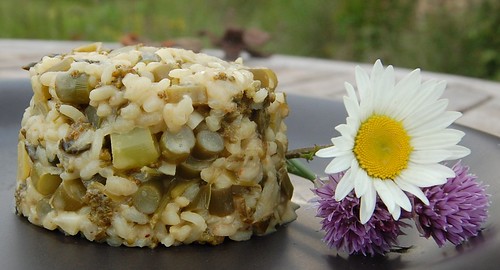Hope everyone had a jolly festive season and received all the love, food and presents that they desired. In my presents this year I received a copy of Heston Blumenthal's Fat Duck tome, which I have had on my wish list for a while now.
Now you might wonder why a vegan home cook would have any interest in the writings of a celebrity meat eating chef with a successful business where each diner has to pay half a week's minimum wage just for a meal before wine, a phenomenon that has informed restaurant food in the UK and the rest of the world for the last 10 years but has almost no application in everday cookery, where the food is poncified to an extreme state and where reservations are taken two months in advance and are most probably fully booked by half past nine on the first Monday of the next month.
Really it is precisely for all the reasons I've listed above that I needed the book. A committed vegan is never going to be able to dine at the restaurant, even the few token veggie dishes are laden with eggs and cheese and even if I could somehow persuade Heston to make an exception for me and create an animal free tasting menu I could never afford it, so the only way I can get a taste of his cooking (and of his brigade of 40 or so staff) is virtually. I can read the book and analyse the recipes and note anything that might add to the vegan cooking canon by virtue of its originality or concept. The experience might be vicarious but it's still valid, it can enhance my food skills and knowledge just as having a meal in the restaurant might do.
There is another reason. Heston isn't mad but he is driven and compulsive in his approach to cooking and that in itself is something that fascinates me; that I can admire because it so far removed from my own rather pared down approach. It is so over the top that it's half way down the other side and that makes for the sort of novelty that can hold my interest. I am captivated by his determination.
This is not to say that everything about the Fat Duck, the book and Heston's public person meets with my entire approval. The restaurant is, as noted above, heavy on the animal products and somewhat exclusive. Some of the television programmes have been annoyingly poor, with scientific and culinary errors that have had me (and the Mr.) shouting at the screen nearly as loudly as we do for Delia.
Anyway, to the book. This is the reduced version of the original Big Fat Duck cookbook that retailed for around £125 last year. I'm not sure what's missing, if anything.
This edition contains an autobiographical section, a recipe section containing many of his more renowned dishes (which presumably are being pensioned off) and a scientific section which I have yet to read. There are also rather a lot of pictures of the man, a good many high quality illustrations which sadly add very little to the experience and some excellent photos of food which is the bit that I need, the visual element of the meal I'm trying to grasp through the literature. Sadly there is no scratch and sniff nor audio chips embedded so that the full sensory experience can be shared.
Sunday, December 27, 2009
Thursday, November 26, 2009
The Worst Bread I've ever made

These really are the heaviest, hardest, most concrete like bricks of bread I've ever made, and I include in that summary all the crumbly pasty doughs of my early youth, before I learned about flour and baker's percentages.
What went wrong? Nothing really. The flour was a white bread flour, from Lidl admittedly but I've used it before with good results. The dough mixed up fine in the Santos, I didn't forget the salt and the yeast, which had received the blame, was almost certainly alive when I added it to the mix, I've proved this by starting another batch with some of its brethren. All fine.
But the water and the kitchen were a bit cold, I wasn't really paying attention, doing a couple of other things at the same time (which it pains me to admit are nearly as unsuccessful) and I've lost my cooking mojo. Just recently, I couldn't care less.
It's pervading my entire life and although I can coast, keep my fingers crossed and be forgiving of my failures really it's not a healthy state of mind. It shows up in everything I do or rather don't do, no painting, no gardening, no blogging. Something has to change so I don't promise anything but I'm going to try harder off screen and hope it boils over into the webbysphere. Fingers crossed.
Thursday, November 05, 2009
Balls

I wanted an aebleskiver pan but despite the fact these originate in Denmark I could only find suppliers in the States. It made me cross to think that something that should be almost local to me here in the UK or France would have to be shipped such a long way.

So, with perfect logic, I decided to buy the Japanese equivalent, a Takoyaki Pan, reasoning that an authentic Japanese pan might have to be ferried half way around the world but at least I'd have the real thing. I ordered it from the Japan Centre in London and with postage it cost me about £35.
It was made in China.
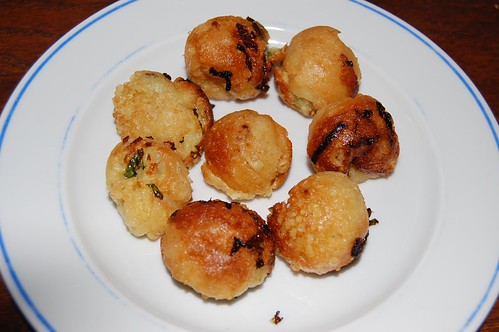
The street food Takoyaki is made with octopus, or sometimes shrimp along with a selection of usual Japanese flavourings, ginger, spring onion, dashi in the batter. This is obviously not vegan and I've yet to perfect a substitute filling because this is only my second attempt with the pan.
For these, I made a simple batter of self raising flour, nutritional yeast and soy milk, flavoured with grated ginger, chopped shallot (no spring onions) and a little finely shredded cabbage. The texture is good and the flavour has potential although once dressed with the traditional Japanese toppings of mayonnaise and brown sauce it's hard to imagine any flavour really shining through them.
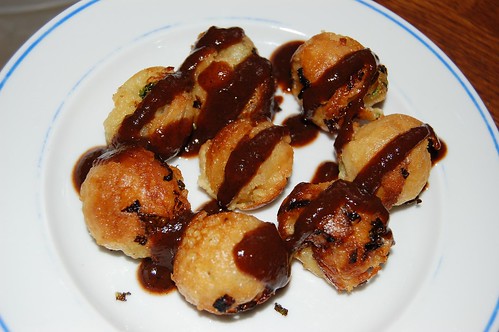
Japanese brown sauce isn't quite Worcestershire, nor Daddies, nor Plum sauce but occupies some special area in between them all. I don't have any and used some of our own "brown sauce" based on green tomatoes and heavily spiced. It's a good substitute but use vegan Worcestershire varieties if you have nothing else.
I skipped the mayo, these babies are already mighty greasy.
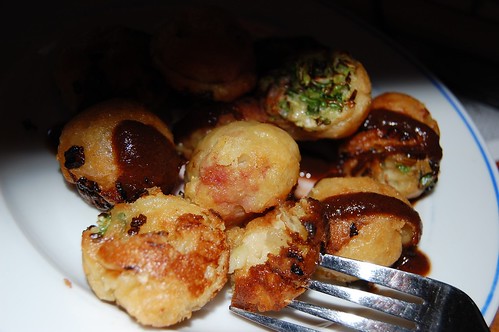
Fried food, you've just got to love it.
Friday, October 16, 2009
The noble potato - part 3

Back in the UK for the winter I've been rummaging through the cupboards, trying to "tidy up" and get rid of junk and clutter we never use.
I found this gadget, a simple microwave safe rack for making snacks from potatoes that look like crisps without any added fat at all. They were all the rage in the Mummy set I inhabited some 20 years ago but are now relegated to the odd items in the miscellaneous sections of online cook and plastic shops. I had a look and could only find them on e-bay.
A compulsion overtook me and I thought I'd try it one more time before consigning it to oblivion.
They're o.k.
You need to slice the potato really evenly and thinly. A mandoline would be good but I couldn't be arsed with the extra need to wash it afterwards so didn't bother. Fill your gadget with one slice per slot, nothing else needed. My hand sliced crisps took about 13 minutes on high in our old microwave, usually only used for defrosting because I'm not a microwave oven fan. Start with five minutes and continue in increments until the crisps are golden brown and puffy.
And you really need the gadget. Trying to stand slices propped up like cards or on their edges just doesn't work and for some reason the increased thickness seemed to encourage the wretched things to blacken and burn instead of crisping up.
So, it's another way to use potato and has some novelty value but it doesn't beat a full fat home fried crisp. I think the gadget may be for the chop.
Tuesday, October 13, 2009
Late to the Party
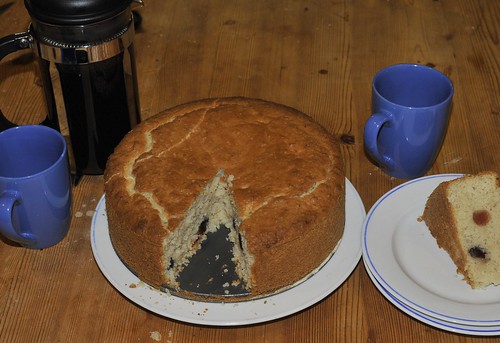
This is my birthday cake. It looks better than last year's which is a bit of a relief!
Coconut and cherries make this just a bit more special than that plain golden exterior suggests. It might have been nice with icing but it's sweet enough already and so I decided to keep it simple. With a good cup of coffee it's phenomenal.
Ingredients
450g self raising flour (use plain with an extra tsp. of baking powder)
120g desiccated coconut
1 tsp baking powder
300g caster sugar
200g glace cherries
125ml vegetable oil
400ml (1 tin) coconut milk, full fat is best.
1 tbsp white vinegar (I used rice but anything, even cider vinegar is fine)
1/2 tsp almond essence (or maraschino flavouring or coconut essence)
1. Preheat the oven to 180C/350F/Gas 4. Ensure your oven is really at this temperature, too hot will ruin everything.
2. Sift the flour and baking powder into a large bowl and stir in the coconut and sugar.
3. Rinse the sticky syrup off the cherries and allow to dry, cut them in half if you like then toss in a couple of teaspoonfuls of flour to coat. This is supposed to stop the cherries from sinking and may have some good effect.
4. Combine all the wet ingredients in another bowl. Pour the wet ingredients into the dry ingredients all at once and mix in gently but thoroughly.
5. Pour half the batter into a greased 23cm/9in springform cake tin and sprinkle the cherries over, then add the rest the batter and level off. Bake for about 55 mins to 1 hour, until a skewer inserted in the centre comes out clean. Remove from the oven and leave to cool in the tin.
6. Turn the cake out of the tin and serve with coffee. If you serve the cake warm you could put a sweet sauce with it and call it pudding.
Tuesday, September 29, 2009
The noble potato - part 2

Scottish Potato Scones
If Latkes are a Jewish staple these simple potato scones might be considered a Scottish one. The ingredients for both are quite similar but for the scones the potatoes are cooked by boiling before mixing with the flour.
400g hot potato (peeled, boiled and drained)
100g flour
40g vegan margarine
1/2 tsp salt
You will need a very heavy pan with a thick base or a griddle to make these.
Melt your margarine. If you do it in your cooking pan it will grease it in the same action.
Mash the potatoes finely, put through a ricer or coarse sieve if you like to remove all lumps but it's not essential. Add the melted fat, salt and the flour to the mash and combine well. It'll be a bit hot to put your hands straight in so use a fork to get the mixture started.
Divide the well mixed dough into two portions. On a well floured work surface gently roll out one portion to a circle about 15-20cms wide (let the size of your pan guide you!) and about 5 or 6 mm thick. Cut the circle into quarters.
Heat your lightly greased griddle or heavy frying pan but don't let it become smoking hot. You need a gentle heat to cook these cakes through. Arrange your scone pieces on the griddle and cook slowly until the underside is golden, then turn and repeat for the second side. It'll be three or four minutes for each side. While you're doing that, roll out the second portion of dough ready for the pan.
Serve warm with spread, marmite or jam. Leftovers will keep for a couple of days, wrapped in the fridge, and can be reheated under the grill or refried to form part of a full British breakfast.
Sunday, September 27, 2009
The noble potato - part 1
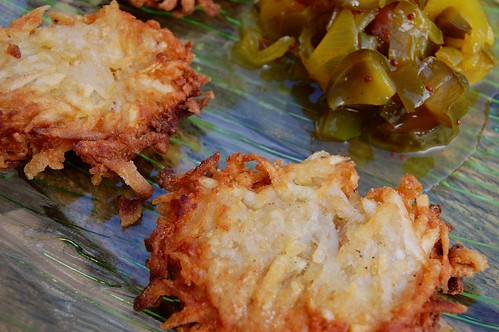
Latkes with sweet green cucumber pickle.
Part of my current difficulties with having an interest in cooking comes down to an immature (think two year old toddler) tantrum about not wanting to eat what's so abundant it's boring.
We have a lot of potatoes this year (and tomatoes and courgettes) and before I've even eaten many I'm telling myself I'm sick to death with them. Pretty stupid because you can make so many very different dishes with potatoes, all of them delicious and mostly easy too. I've given myself a talking to and will, in penance, attempt a short series of potato based posts, interspersed with anything really good that comes up, showcasing the many ways the spud can make a good meal.
Latkes are potato cakes made with grated raw potato and fried in plenty of oil. So far, so good but when you actually come to research this traditional Jewish recipe, which is made especially for Hanukkah but also at other times of the year, you find that the variations on the theme are legion with vegetables, flavourings and even cheese added.
Consequently I have little concern over offering my own recipe version, which is veganised by leaving out the egg! I have to come clean though and admit these are the first really successful potato pancakes I've ever made, previous attempts have been passably nasty but at least this has allowed me to identify the essential points to address.
Peel and grate some potatoes. Much is made of the variety but I used a mix of waxy (Pink Fir Apple) and floury (old Epicure) and didn't have any problem. Use a large grater, it's less grief in my opinion. Three medium potatoes made enough for eight cakes.
Finely chop a small onion and add it to the potato. Don't add too much, onion is watery and sugary. The water makes the cakes gummy and the sugar will burn before the potato part is cooked. On the other hand, the flavour is much improved by the allium.
Put the potato onion mixture onto a clean tea towel, gather up the corners, go outside somewhere and comprehensively take your aggression out on it, squeezing those vegetables until they are as dry as really dry things.
Put the dried veg into a bowl and season lightly with salt and pepper. Now, I didn't weigh anything this morning so you'll just have to go with the flow. Sprinkle over enough white flour to coat each shred with a light dusting. Use your fingers to toss the flour through the mixture and allow any excess to fall to the bottom of the bowl. Using your hands take small portions of the floured potato and squeeze it into small flat cakes, not more than 1cm thick and about the size of the palm of your hand. Do several and set them to one side.
Heat a heavy frying pan with about 1cm of olive or other fresh oil in it until it is hot but not smoking. Place 4 or 5 of your little cakes into the oil, not too close to each other. They should sizzle as they hit the fat, then reduce the heat a little. You need to cook the cakes through before the outside burns so expect to take several minutes for each batch of latkes. Squash the cakes down as the first side cooks to spread them out a little and turn them once during cooking so that each side becomes golden.
Drain on kitchen towel and serve as quickly and as hot as possible.
Tradition has them served with apple sauce which I think would be lovely but I didn't have any so had sweet cucumber pickle instead which made a similar combination.
Friday, September 25, 2009
Lacking in the execution
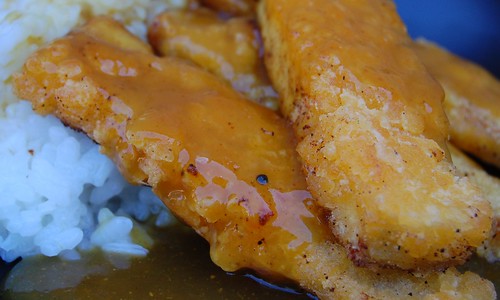
Tofu Fingers in a Chinese Curry sauce
This was a nice enough idea, seasoned tofu fingers coated in cornflour and fried in plenty of oil is always a good start but the rice was mismanaged and the sauce inadequate so no recipe tonight. This is just to remind myself I need to try harder next time.
Still I may allow myself a glass of wine, just to help my digestion you understand.
Wednesday, September 23, 2009
Breakfast?
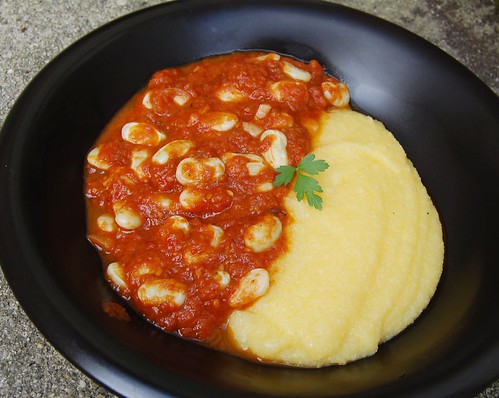
In a startling reversal of the space-time continuum I'm now working my way through 10 more days without a car or any access to things beyond the garden and the pantry stores. Not such a big deal as we discovered before but it does lead to some issues with everyday foods that are easier to buy in for one consumer. Like bread.
Yesterday I got over this problem by making chapatti which were bloody good if I say so myself, they cooked perfectly and by chance or design I got exactly the softness and puffiness I desire. Unfortunately, giving the recipe out for them is like giving out the recipe for wallpaper paste. It's just flour and water, it's what you do with them that matters and that is so difficult to explain.
Today I crumbled, (ha, get that!) and took the last loaf out of the freezer but it still wasn't thawed in time for breakfast. Enter the instant polenta.
Instant polenta has a bad press, probably mostly from people whose formative years were spent breaking their elbows stirring the 'real' stuff for an hour while dodging the explosive bombs of hot paste spluttering from the pan.
The instant stuff probably isn't as good, but it sure is convenient. Easiest to measure by volume, an espresso cupful (about 60ml although you don't usually get a full cup of espresso) is enough for two not terribly hungry people. Add four more cupfuls of cold water and heat, stirring continuously over a gentle heat for about FIVE minutes. You'll know it's done when it gets thick and starts leaving a trail behind the spoon in the pan. Add a good dollop of oil or vegan marge and you're ready to serve.
I split mine into two portions, one to eat hot and the other to chill and be fried in slices later. With the hot I served homemade beans in sauce. The garden is providing a lot of shelling beans at the moment and with some shallots, garlic and tomato sauce I made this not terribly delicious hotpot type thing which went quite well with the starchy polenta.
I will give you my tips for flavouring though because that worked quite well. A little bit of white pepper adds something that black pepper misses, probably because ready ground white pepper is slightly fermented. You can become quite a white pepper aficionado because various brands and batches may have quite different flavours and I'm well on my way to becoming one. With the white pepper, a pinch of ground allspice works nicely with the tomato although a single clove would also do the job as long as it was removed before eating.
More tomorrow I hope but I've been having a run of failures in my recipes recently, probably because food isn't top of my priorities at the moment, and there hasn't been a lot to share about it.
Monday, September 14, 2009
Flapjack
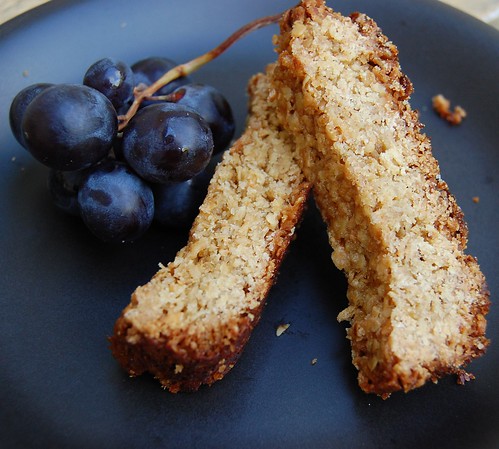
I had a whole long story to go with these, as well as my own recipe but for reasons that are best not gone into I'm too cross now to tell it properly. The recipe is a reliable one from The Complete Farmhouse Kitchen cookbook, the book of the TV series that informed many of my afternoons spent skiving from school.
Makes 15
75g marg.
2 tbs. golden syrup (about 50g)
75g dark sugar
150g rolled (porridge) oats
Grease a shallow tin, about 18cm square (or line with parchment or ideally both)
Put marg, syrup and sugar into a saucepan and heat gently until all is warmed and dissolved.
Remove from heat and mix in oats.
Spread into prepared tin and press down well.
Bake in a moderate oven 180C for 15-20 minutes. The colour should be just golden but it will burn quickly if you leave it in too long.
Remove from oven and allow to cool for five minutes, then mark into bars. Allow to cool completely before breaking into sections. Store in an airtight tin. Keeps three weeks.
This basic recipe can be gussied up with added dried fruit or coconut flakes if liked.
Saturday, September 12, 2009
Baked Quinoa with Plantain Chips

A while back I was bemoaning the fact I couldn't find plantain in Normandy. Somebody must have been listening because I've found them in a couple of places since then.
Inspiration enough to step up to the cooker.
The Quinoa Bake is, because this is France and that's the way they sell it, actually Quinoa and Bulgar based. I would have preferred 100% quinoa but if you want to do exactly as I did then make a 50/50 blend or even just use bulgar in extremis.
Cook your quinoa in plenty of simmering lightly salted water for about 15 minutes, until the curly germ springs loose and the grain is soft and palatable. Drain and place into a well greased oven dish. Put a layer of fresh sliced tomato, not too thick on top - I used yellow tomatoes and sort of wished I had tomatilloes - then cover that with some thick tomato coulis or passata. Sprinkle with a little salt and some dried mixed herbs.
Make a handful of breadcrumbs, wholemeal for preference, grate in some vegan cheese and season well with black pepper. Use this to top off the bake, sprinkle with a little oil and pop into a hot oven.
To make the chips; peel and slice your plantain on the diagonal (or slice and peel if this is easier!). Fry quickly on both sides until just starting to turn golden, then remove from the pan and with spatula and some pressure squash each slice until it spreads a little.
Put onto a baking tray, add salt and hot pepper flakes to taste and put them into the oven with the bake for 20 minutes or so. The chips should be golden and the top of the bake browned and crispy.
Serve with a little hot sauce of your choice. This is really good.
Saturday, August 29, 2009
What a pickle
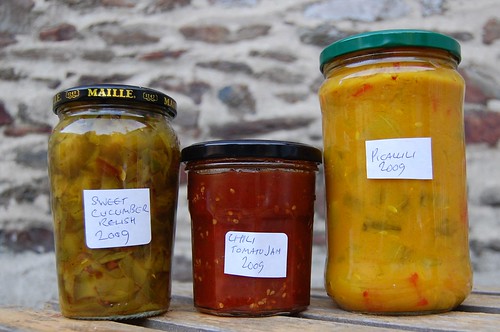
I've not been doing much meal cooking. This last hot week of August has had me eating bread and tomatoes for most meals except for a few days when catering for a guest, when we ate traditional favourites that wouldn't stand to be blogged yet again.
But nature abhors a vacuum apparently. To take up the slack on my time in the kitchen I've been trying to preserve some of the harvest for later in the year. It's something I'm a bit ambivalent about - I love pickles and jams to eat as well as to make but we often find ourselves with a glut of produce turned into a glut of storage goods and still they don't get eaten up. It's just more effort and money in sugar, vinegar and fuel that is ultimately wasted. Still, there are some preserves that we do come back to year after year and if I'm careful with the quantities we'll have finished them up before we're bored of them.
This week I made some hot tomato jam, based on the Mark Bittman recipe here. This recipe is a good starting point for your own flights of flavouring fancy, and I think spicy hot is the way to go. Last year I made some and it was all finished within the month, it was that good. A word of warning though, take care when bottling it. I bottle into hot jars and still managed to crack the bottom off one with this very high temperature preparation. Most annoying.
The Piccalilli is the British standard recipe enshrined in Government handouts since at least the 2nd World War although mysteriously any number of celeb. chefs seem to have their own version. I adore the sweet mixture of ground ginger and turmeric which is the basis of the flavouring. For American readers I should point out that this is pretty much Bread and Butter pickles but Brits like to put cauliflower and onions in theirs. It's a cultural thing. It can be made hot, sweet or both.
The Sweet Cucumber relish is a little less well known so I'll give you the recipe below. We like it very much, sweet and sour with an intriguing flavour from the celery seed. Good on burger type things and in sandwiches.
Sweet Cucumber Pickle
All weights after preparation:
1kg cucumbers, you can use pickling cukes that have got away for this or shop bought ones, it makes little difference. Wash them well and slit lengthways to remove the seeds and wet pulp, then chop the flesh into neat cubes a little smaller than 1cm square. No need to peel unless the skin is really tough.
500g white or yellow onions, chopped finely
300g sweet peppers - use red or green or a mixture. Seed and remove the white pith and then cut into fine short slivers.
Mix all these chopped vegetables in a big bowl with 25g of cooking salt, cover and leave to sweat out their juices for at least 2 hours, and up to 8 if it suits your schedule.
The vegetables will produce a lot of juice. With your bare hands or some improvisation with tea towels and stick, squeeze out all of this juice and put the dry vegetables into a clean stainless steel pan. Most of the salt will be left behind but if it worries you, you can rinse the veg. well before the squeezing operation.
Add 500ml of good quality cider or white vinegar - this is mainly to keep the colour, as dark vinegar won't affect the taste, just the looks.
Simmer the vegetables in the vinegar for 10 minutes or so until just tender. There is barely enough liquid so keep the lid on but don't be tempted to add more because, well, because I say so.
Add 500g white sugar (the devil's food), and 1 tsp. mustard seed (yellow or black!). Then add half teaspoons of turmeric (don't overdo this, the colour again) and celery seed. Avoid ready ground celery seed if you can, I couldn't, the French are weird. Finally add just a pinch of ground cloves, they're really really strong.
Stir everything over a gentle heat until the sugar dissolves, then bring it all to a boil for a couple of minutes.
I pot hot, into sterile jars and seal immediately. This is the British way and the pickle will keep good in a cool dark cupboard for a year, only needing refrigeration after it's been opened. Lift the solids with a slotted spoon into the jar (a jam funnel is an excellent aid at this moment) and then top up with the juice, tapping to remove air bubbles. If you didn't squeeze hard enough or added too much vinegar you'll have a lot of juice left over, don't say you weren't warned. Be careful, it's hot!
If you prefer, allow the cucumber relish to cool, fill your canning jars and process in the way recommended for other pickles.
Saturday, August 22, 2009
Gado Gado
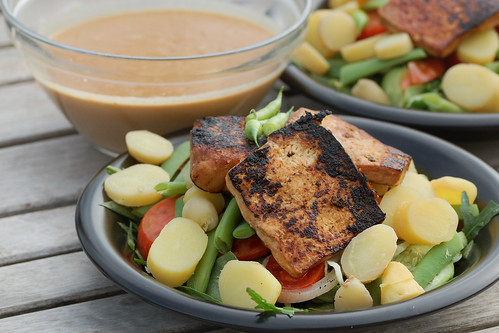
The well known Indonesian dish made from cooked and raw vegetables served with a spicy peanut sauce. It's an excellent summer supper, made with vegetables from the garden, whatever you have and lots of rich creamy dressing.
Because every time I make this, I make it slightly differently I'm not going to give much of a recipe; assemble some fresh chopped green leaves, I used rocket here and top with sliced cucumber, slices of cooked potato, lightly steamed green beans, tomato if you like (wiki claims this is not traditional) and seared tofu. The strange little pods in the picture are green seed pods from the radishes, crisp and gently spicy. Coriander leaf is a nice but not essential addition.
Use a commercial sate sauce or whip up your own from peanut butter, dark sugar, lime juice, soy sauce, garlic, a little oil, chillies to taste and enough coconut milk and water to make a smooth pouring sauce, simmered a little to combine the flavours and served warm. I usually use the marinade from the tofu as a base adding peanut butter and coconut milk to make the sauce.
Enjoy on any summer's evening.
Thursday, August 20, 2009
Courgette Bruschetta
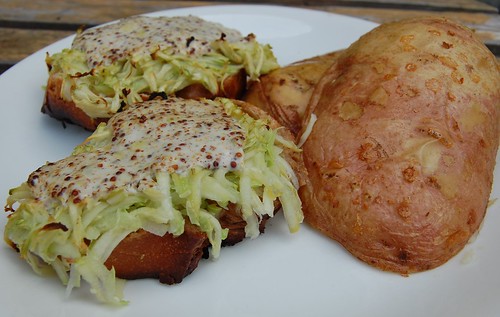
I'm almost totally off my food and not that thrilled with anything else for that matter.
This evening, in a vain attempt to catch up with the courgettes I intended to make a zucchini bread or some cup cakes or something. I turned on the oven and slung a couple of potatoes in to start cooking so as not to waste any gas but my enthusiasm ran out at that point. So I made these tasty little snacks instead.
Slice up some day old french bread, baguette or other dry white loaf into neat slices. Brush with oil and lay out in a heavy baking tray. Grate your courgette or young marrow, no need to peel and season lightly with salt and pepper.
Pile the grated vegetable onto the bread slices and top with soy yoghurt mixed with a liberal amount of grainy mustard or flavour it as you will, I happen to particularly like this combination. Drizzle a little more oil over the top of everything and bake in a hot oven for 30 minutes or so until the bread is golden and crispy.
Eat as a snack, light hors d'oeuvre or with potatoes as a full supper. Best with wine.
Tuesday, August 11, 2009
Lunch for two
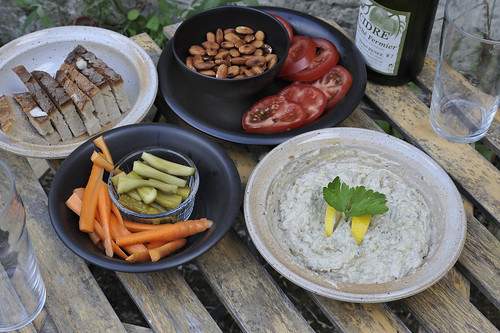
Toasted almonds, home grown tomatoes, baba ganoush, carrot sticks, dill pickles and bread. A wonderful hot day lunch in the garden.
Wednesday, August 05, 2009
Tarte de Fèves with Garlic Roasted Potatoes
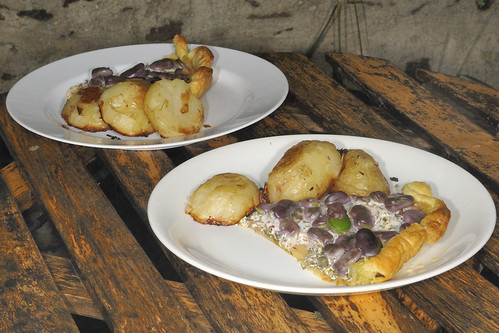
This is a really simple meal we made a few weeks ago with some of the home grown broad beans and a sheet of ready made puff pastry.
Lay the pastry out in a suitable flan baking tray. Mix a couple of tubs (about 200g total) soya yoghurt with a big spoonful of grainy mustard and other seasonings to taste and spread across the base.
Top with tender broad beans or other fresh garden vegetables, slivers of courgette are delicious.
Bake in a hot oven until the pastry is crisp, maybe 25 minutes and serve with potatoes smothered in oil and crushed garlic and roasted until golden or other favourite accompaniments.
Wednesday, July 22, 2009
Chanterelles
It's not all food from the vegetable patch. Yesterday, whilst walking the cats, I found three chanterelles. This is thrilling, I didn't think they grew in our woods and it's terribly exciting. Chanterelles are some of the most delicious and sought after fungi in the forest. I shall be going back to look for more.

These are some of the easiest fungi to identify but it's still possible to make painful or lethal mistakes. I was lucky enough to be shown how to identify them by my Swedish relatives. All Swedes are demon mushroom gatherers and it's practically a national sport for them. If you're not so lucky with your family, try to join a mushroom hunting walk with an expert or study your books very carefully.
Things to note from the picture are the beautiful yellow colour, not shaded or patchy in any way, the ridges under the cap which extend down the stem and the solid and sturdy growth. You will read that they have a fruity smell a little like apricots. This may not be apparent while you're gathering them but if you keep them in a paper bag for an hour or two and then sniff the fragrance will probably be there to a lesser or greater degree.

I didn't really have enough for much of a production. Simply sliced, fried in a little oil with just a smidge of garlic (I used one thin slice from a clove with these) and a good sprinkle of pepper made a wonderful breakfast.


These are some of the easiest fungi to identify but it's still possible to make painful or lethal mistakes. I was lucky enough to be shown how to identify them by my Swedish relatives. All Swedes are demon mushroom gatherers and it's practically a national sport for them. If you're not so lucky with your family, try to join a mushroom hunting walk with an expert or study your books very carefully.
Things to note from the picture are the beautiful yellow colour, not shaded or patchy in any way, the ridges under the cap which extend down the stem and the solid and sturdy growth. You will read that they have a fruity smell a little like apricots. This may not be apparent while you're gathering them but if you keep them in a paper bag for an hour or two and then sniff the fragrance will probably be there to a lesser or greater degree.

I didn't really have enough for much of a production. Simply sliced, fried in a little oil with just a smidge of garlic (I used one thin slice from a clove with these) and a good sprinkle of pepper made a wonderful breakfast.

Tuesday, July 21, 2009
All from the Garden

Not really been cooking these last few days again. This is what I've been eating, variations on potato salad with all the main ingredients being home grown and very simply prepared.
To vary tonight's supper, I baked the potatoes and beetroot before chopping up, mixing with a little chopped shallot (not in the picture, I forgot but added it afterwards!) and some blanched skinned broad beans and dressing in a little soya yoghurt with grainy mustard.
Other garden produce based meals are huge pots of leafy greens, leaves from the beets, magentaspreen, thinnings and trimmings, quickly wilted down, chopped and seasoned with pepper and cider vinegar or stews of cubed vegetables simmered in vegetable stock and miso and served almost as a soup with nutritional yeast as a garnish. All rather basic stuff and would be horribly boring except for the joy of picking my dinner minutes before I eat it and knowing that the work is all mine.
I've been working out some new ways of using courgettes too, but I'll save those for another post or there'll be nothing to write about next week. Hope you're all enjoying your summer cooking.
Friday, July 17, 2009
Wheat and Peas

In this case, bulgar wheat and chickpeas. I've just read an interesting article on Agricultural Biodiversity about diet, referencing work that tentatively suggests eating bitter vegetables and marginal foods may increase your life span because the body recognises that the food isn't optimal for offspring and damps down the reproductive systems. That's rather a poor precis so I recommend you follow the link to Jeremy's piece and go on from there.
This light evening meal isn't particularly poor nutritionally but does include some food that might only be eaten in desperation, beetroot leaf stalks. They were just so pretty and succulent looking that I couldn't bear to waste them.
Cook some bulgar (pre-cooked whole wheat grains, cracked and dried) in twice its volume of water. Add a little salt and herbs if you desire. The bulgar takes about 10 mins to cook so after five minutes add your washed and neatly chopped beet leaf stems (just like chard really!) and allow the whole thing to cook. Take off the heat after another five minutes, cover and leave to cool while you prepare the rest of the salad.
I used a lot of cucumber in this, had to or it would have ended up in the compost, shallots, chickpeas (from a tin or otherwise precooked), parsley, lemon juice, a little olive oil for flavour, salt and pepper, effectively making a warm tabbouleh with beet stems in it. I needed to sharpen the flavour with a teaspoon of cider vinegar but it's by no means essential, adjust to your own taste by varying the amounts of lemon juice.
Subsistence food perhaps but pretty good.
Tuesday, July 14, 2009
A curry of Pumpkin Tips
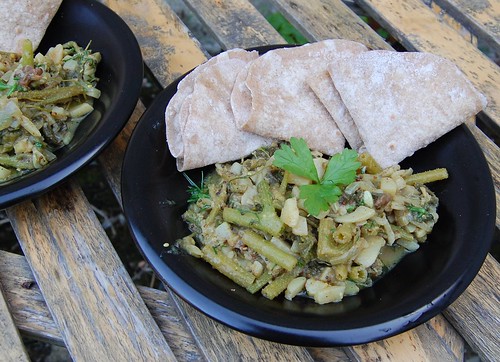
Not many cooking exploits to record, the harvest is beginning and simply cooked veggies from the garden (think new potatoes and broad beans in no particular order) are making most of my meals.
This though, is a slightly more complex preparation utilising some pumpkin prunings, the luscious tender tips of the vines. It's a less well known way of using cucurbits, in the UK we tend to wait for the fruit but if you're hungry the greens make good eating. I had to cut the tips anyway, as the plants need training to stop them overwhelming everything around them.
Serves two.
Prepare some pumpkin tips. I had seven or eight. Use just the top 15cm or so with one or two leaves chopped into 3cm pieces and rinsed well.
Chop a boiled potato or two into small dice. I used some leftovers.
Take:
3 cloves
1.5 dry red chillies
1 teaspoon cumin seed
1 teaspoon coriander seed
1/2 teaspoon black peppercorns
2 teaspoons sesame seed
Toast these spices in a dry pan for a few moments until fragrant, then cool slightly and grind into a fine powder in a spice grinder or your pestle and mortar. Adjust the chilli heat to suit your self.
Add to the ground spices:
1/2 teaspoon ground cinnamon (you can use some whole cinnamon and grind it with the other spices above if you like)
1/2 teaspoon ground turmeric
Grate:
about 3cm fresh ginger root
3 or 4 cloves of garlic
Chop finely:
1 medium onion
Gently fry the onion in some vegetable oil until starting to colour, then add the garlic, ginger and spices and mix together.
Add:
a small piece of tamarind paste soaked in a little warm water (or use 1 tsp. vinegar)
Add the potato and pumpkins tips along with some water, about 300ml should do it but you need to adjust this to your taste. The greens exude some liquid during cooking.
Stir well and cover the pan to cook gently while the greens wilt. Should take about 10-15 minutes. Add some chopped coriander leaves and mix in.
Sizzle a couple of teaspoons of mustard seed in some oil and pour over the curry at the end of cooking.
Serve with chapathis.
Tuesday, June 30, 2009
Tofu Sambal, Indonesian style
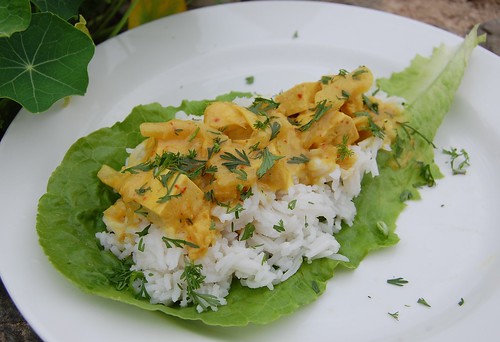
This is based on the more traditional sambal made with hard boiled eggs. I usually serve it as part of a meal for several people and accompany it with sate, peanut sauce, sesame fried cucumber, salads and lots of rice. It can be as mild as you like which makes it a good option for the rijsttafel to offset other spicier offerings.
Best made with softer chinese tofu I've had to use the unfriendly and dense Bjorg version here which has damaged the texture of the finished dish a bit, but use what you have, it will still be delicious.
For about four people with rice and sides
400g soft tofu
Peanut oil
A medium onion or 3 or 4 shallots
several cloves of garlic (as many as you like)
a small mound of grated ginger (about 3cm of a thick root)
a red chilli, chopped (hot or mild to taste)
some hot pepper flakes or vegan sambal oelek
a tsp. brown sugar
a pinch of turmeric
a tsp. of dark miso
400ml coconut milk
salt
Juice of a lime (or half a lemon)
Finely chop the onion or shallots and gently soften in a good splash of oil. Don't let them brown. Add the ginger, chilli and garlic and stir around for a moment to take the rawness off.
Add the sambal oelek or red pepper flakes to taste. This shouldn't be blisteringly hot and you can leave the heat out altogether if you need to. I used a couple of shakes of pepper flakes but would have used a flat teaspoon of sambal oelek if I had it.
Add the coconut milk and sugar. Traditionally fermented shrimp paste is used in this to enhance the flavour. I have substituted a teaspoonful of dark miso and some extra salt. I also use a pinch of turmeric for an auspicious golden colour but it's not essential.
Mix everything together well and simmer for a couple of minutes. Add the tofu, cut into neat cubes and allow everything to heat together until the tofu is warmed through and the sauce has thickened slightly. Stir in the lime or lemon juice.
Serve with rice and sprinkle with a bit of chopped coriander if you have it.
Sunday, June 28, 2009
Chips and Jam
hmmmm, not much of body as a temple this week. I found I had a quantity of old potatoes left over from a bag brought home just before we started the new harvest here. I was going to make mash but the devil spoke into my ear and I ended up with chunky chips.
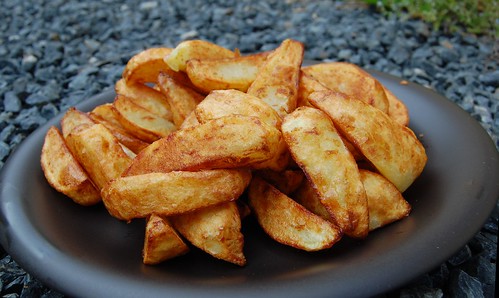
yes, it is rather a lot on the plate for one person. I've put some aside to make salad with tomorrow.
For pudding then, something healthy. Raw strawberry jam also known as strawberries mashed with a little raw sugar and elderflower snow, also known as old sorbet that's got a bit hard and needs to be shaved into the bowl. It still tasted good.


yes, it is rather a lot on the plate for one person. I've put some aside to make salad with tomorrow.
For pudding then, something healthy. Raw strawberry jam also known as strawberries mashed with a little raw sugar and elderflower snow, also known as old sorbet that's got a bit hard and needs to be shaved into the bowl. It still tasted good.

Tuesday, June 23, 2009
Takeaway
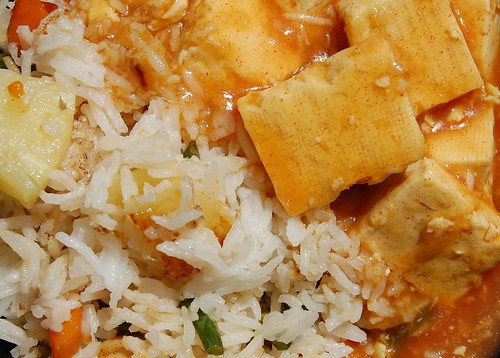
Sweet and Sour Tofu with Pineapple Fried Rice.
There's a takeaway near where we live in the UK, in Bletchley in fact. I may have mentioned it before, in an area with almost no provision whatsoever for vegetarians or vegans this little gem of a restaurant (they do have some tables but some sort of doom hangs over us and we always have a horrible argument so we've stopped trying to eat there) is almost entirely vegan with just a couple of items on the menu suitable for vegetarians only. Nothing for meateaters at all!
They do make use of a lot of fake meats and ersatz ingredients and I have to say I'm not a great fan of some of these but just being able to stick a pin in a full sized Chinese menu is such a thrill I'm willing to try almost anything. It's one of the first places we head to when I've returned to the UK for the winter.
That moment is quite a long way away at the moment, this will be the longest period I've ever stayed in France without a trip away, if only for a few days. Blame the kittens, or more accurately blame the British Government, the kits don't give a damn.
Anyway, I decided to indulge in a bit of DIY and make my own. It's not quite as good as our usual selection but it's considerably better than some offerings from other Chinese takeaways we've tried.
Monday, June 22, 2009
Light lunch
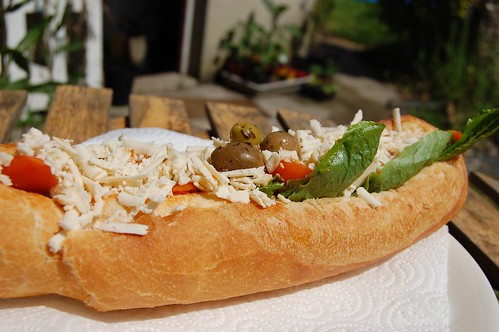
Carrot salad sandwich with Cheezly.
The carrot salad was made rather like a vinaigrette dressed potato salad. Lightly cooked carrot pieces, mountain cut, were dressed in a whisked oil and vinegar dressing made Moroccan by the addition of hot sauce, sugar, paprika, cumin seeds, salt and pepper.
Cheezly was part of a care package brought over by the Mister. It doesn't seem to have a market in France.
Sunday, June 21, 2009
Celebration Dinner 20th June 2009
Mr. Stripey Cat joined me this weekend to celebrate 12 years of partnership. Doesn't time fly when you're having fun?
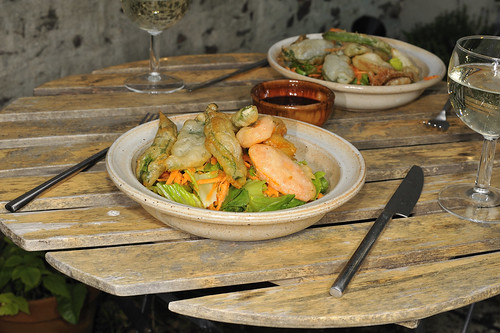
Starter of Mixed Vegetable Tempura in a Sparkling wine batter.
The vegetables used were carrot slices, onion sliced through the root to give disks, green pepper, whole broad beans in pods and comfrey leaves. It was served on a simple grated salad with a garlic ginger dipping sauce.
I was really pleased with the tempura. The batter was a mix of 50/50 cornflour and wheat flour beaten just before using with enough sparkling dry wine to make a thin coating on the vegetables. The crunch was robust enough to hold its character while everything was fried and plated meaning we could sit and eat together, rather important for this meal.
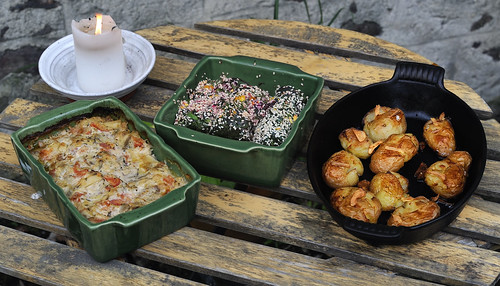
Greek Aubergine Bake with crushed garlic potatoes and sesame coated horta.
The aubergine bake was based on a recipe I last used about 20 years ago, and originally contained feta cheese. For a vegan version I substituted soy yoghurt and some Cheezely. The flavour was good but the yoghurt separated during the long oven cooking and looked a bit unattractive. More work needed before I release it to an unsuspecting public.
We've been harvesting our new potato crop eagerly but are agreed that the flavour of the baby spuds this year hasn't been great. To give these a bit of character they were par boiled, crushed a little and then coated in olive oil and garlic slivers before roasting in a hot oven for 45 minutes or so. Very easy and adaptable, they will keep warm succesfully if the first course over runs.
The sesame horta was another really delicious dish. Greens from the garden, leafy weedy magentaspreen, beet thinnings just beginning to make tiny beetroots and Good King Henry, were blanched briefly to wilt them, drained and cooled. They were squeezed by hand (this was a very manual cooking experience) into a long sausage, dressed with lemon zest and toasted sesame, cut into sections for the baking/serving dish and drizzled with a little good olive oil. They were then popped into the oven for 20 minutes so that they were warmed in time to serve with the main course and potatoes.
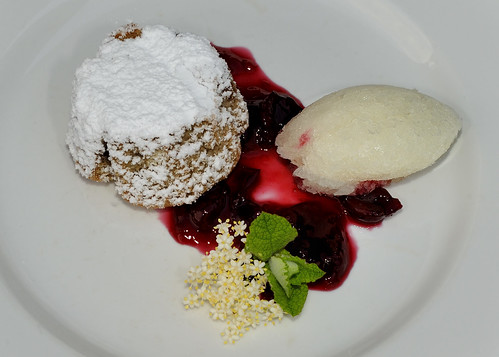
Cherry sponge on a cherry conserve with Elderflower sorbet.
A tender sponge filled with fresh, pitted, cherries and cooked in a muffin tin to make serving portions. The sorbet was made by using some of the elderflower syrup made a couple of weeks ago sharpened with extra lemon and the ice crystals rendered a little smoother with a big splash of gin.
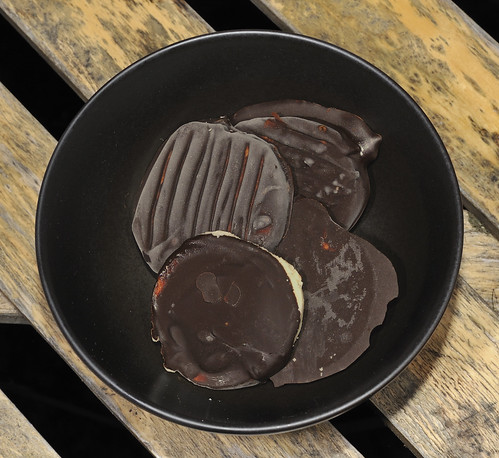
Almond fondants.
To have with our coffee I made these rather simple chocolate coated fondants which I had intended to flavour with peppermint. Alas, the countryside French don't have any need for peppermint oils and I wasn't able to get any flavouring so had to use almond instead. They were very sweet but as we'd eaten so much we really didn't need more than one each.
Of course, there were loads of leftovers but we had them for lunch today. And now he's gone back to the UK and the cats and I are alone again for another few weeks.

Starter of Mixed Vegetable Tempura in a Sparkling wine batter.
The vegetables used were carrot slices, onion sliced through the root to give disks, green pepper, whole broad beans in pods and comfrey leaves. It was served on a simple grated salad with a garlic ginger dipping sauce.
I was really pleased with the tempura. The batter was a mix of 50/50 cornflour and wheat flour beaten just before using with enough sparkling dry wine to make a thin coating on the vegetables. The crunch was robust enough to hold its character while everything was fried and plated meaning we could sit and eat together, rather important for this meal.

Greek Aubergine Bake with crushed garlic potatoes and sesame coated horta.
The aubergine bake was based on a recipe I last used about 20 years ago, and originally contained feta cheese. For a vegan version I substituted soy yoghurt and some Cheezely. The flavour was good but the yoghurt separated during the long oven cooking and looked a bit unattractive. More work needed before I release it to an unsuspecting public.
We've been harvesting our new potato crop eagerly but are agreed that the flavour of the baby spuds this year hasn't been great. To give these a bit of character they were par boiled, crushed a little and then coated in olive oil and garlic slivers before roasting in a hot oven for 45 minutes or so. Very easy and adaptable, they will keep warm succesfully if the first course over runs.
The sesame horta was another really delicious dish. Greens from the garden, leafy weedy magentaspreen, beet thinnings just beginning to make tiny beetroots and Good King Henry, were blanched briefly to wilt them, drained and cooled. They were squeezed by hand (this was a very manual cooking experience) into a long sausage, dressed with lemon zest and toasted sesame, cut into sections for the baking/serving dish and drizzled with a little good olive oil. They were then popped into the oven for 20 minutes so that they were warmed in time to serve with the main course and potatoes.

Cherry sponge on a cherry conserve with Elderflower sorbet.
A tender sponge filled with fresh, pitted, cherries and cooked in a muffin tin to make serving portions. The sorbet was made by using some of the elderflower syrup made a couple of weeks ago sharpened with extra lemon and the ice crystals rendered a little smoother with a big splash of gin.

Almond fondants.
To have with our coffee I made these rather simple chocolate coated fondants which I had intended to flavour with peppermint. Alas, the countryside French don't have any need for peppermint oils and I wasn't able to get any flavouring so had to use almond instead. They were very sweet but as we'd eaten so much we really didn't need more than one each.
Of course, there were loads of leftovers but we had them for lunch today. And now he's gone back to the UK and the cats and I are alone again for another few weeks.
Saturday, June 13, 2009
No recipe required

This is, one way or another, pretty much what I've been eating for the last week.
Vegetable stew, made with some bought and some gathered vegetables, ingredients served with a carbohydrate.
Sometimes the stew is more soupy and I eat it with bread, sometimes I mix the rice or pasta straight into the pan, tonight I made polenta, cooled it in a sheet and then refried sections to top off the vegetables. I haven't done it yet but I suppose the next alternative would be to make some dumplings.
It's reasonably healthy, undeniably cheap and extremely easy to make but it's not haute cuisine or anything approaching innovative cookery. I don't know when my interest in food preparation or recipe creation will return.
Sunday, June 07, 2009
Potstickers on Ice

Not a new recipe exactly, more the necessary modifications made in the face of inappropriate ingredients. Vegan potstickers are most likely to be filled with a heavily seasoned mixture of chinese cabbage and mushrooms.
In the absence of those items today's filling comprises shredded onion and carrots, along with a small tin of beansprouts (I'm in France remember!) and a bunch of weed seedlings, in this case magentaspreen, seasoned with a small semi-dry (aka nearly off) chilli and some garlic.
Stir fry everything together adding the garlic and chilli last and allow to cool.
It's usually recommended that potsticker wrappers are bought from the Chinese supermarket, but it's perfectly possible to make your own and they can be as dainty or substantial as you want them to be. I wasn't in the mood for prissy and the robust filling needed a sturdy surrounding so I made a simple flour and water dough, very similar to the lagana paste (or indeed pasta or chapatti or any number of simple pastries) and rolled small portions out thinly filling them as I went. These are probably a bit big for guests but as a substantial lunch in private they weren't at all bad.
Heat some oil that will take a high temperature in a frying pan with a lid and quickly fry the little parcels (I usually make mine like the picture but other shapes are acceptable) so that the bottom becomes crispy and golden then with the heat still high add about 150ml of stock (or water at a pinch) to the pan and put the lid on. Allow to cook, covered for about 10 minutes or so until the stock is absorbed and the dumplings are cooked through. Serve with the dipping sauce of your choice.
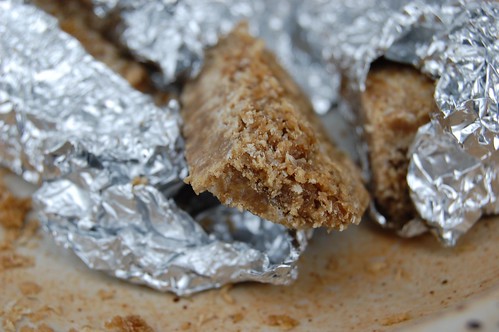
Drugs are baad.
This, despite appearances to the contrary, is coconut ice made with brown sugar. It's delicious, but there's a reason I rarely make sweets or cakes. I can't stop eating them.
Very easy to make I did all this entirely by eye so can't give you a proper recipe but there are plenty on the web. Basically you make a sugar syrup boiled to soft ball stage, mix in desiccated coconut and sometimes flavourings or colour and press out in a pan to set. The usual flavour is vanilla which works well and the colouring is often pink, added to just half the batch so that a double layer of pink and white can be formed. I didn't think the vanilla or the pink would be worth the trouble given the brown sugar.
It's incredibly sweet, and fattening and I've nearly finished the entire batch since last night. Drugs are bad.
Thursday, June 04, 2009
Lettuce and Tarragon Risotto
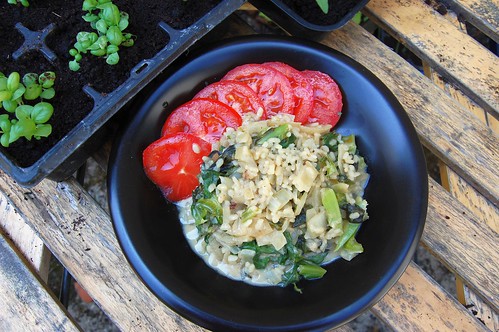
Although I'm perfectly comfortable with the fact leaves are good for you and even evangelise about it to others from time to time I find actually eating a lot of raw vegetation really quite dull. This is a way of getting more leafy greens into me, without my jaw aching. Regular readers will also note that it's a way of getting more of my favourite white rice included in my diet, but that's not important right now.
At the risk of boring everyone I'll just run over the steps involved in risotto again.
Chop an onion (or shallots) finely and melt down in some olive oil. It's o.k. to use a tad more oil in a vegan risotto as there will be no added fat from cheese or cream.
Put in a quantity of rice, probably a little less than you think you'll need. Risotto rice is always recommended but as it happens I've been using some Riz Rond (aka pudding rice) and the sky hasn't fallen yet. It's working just fine.
Get the rice oily and warmed. Chuck in a good glassful of white wine. I've got a bottle of cooking wine, a (just) drinkable Blanc de Blancs vin de table but if you're buying in a dry Italian wine or a Muscadet is probably better.
Let that sizzle and boil. Add a quantity of chopped tarragon. If you have no tarragon a spoonful of Pastis is good or a slug of vermouth. Add salt and black pepper.
The stock; don't use a stock cube unless you crave monosodium glutamate (which happens), plain water will do. The water doesn't even have to be hot although if you're using cold add it in small doses so that the pan never stops cooking. Of course if you have a good and compatible vegetable stock to hand use it by all means.
Add liquid in small quantities, stirring regularly and keeping the pan simmering, until the rice is nearly cooked.
Add another wine glass of liquid and some nutritional yeast. This really does do most of what the parmesan would do in a traditional recipe but it needs moisture to dissolve in and adds no fat. Don't overdo it, it is a matter of taste how much you'll need.
Stir everything around and pile in a lot of washed, roughly chopped lettuce. Put the lid on the pan to help it wilt down a bit and then remove the lid and stir it in. You may need a little more stock or water but the lettuce gives off quite a lot of liquid as it cooks. Keep stirring, testing the rice and observing until everything is cooked to perfection and serve.
Tuesday, June 02, 2009
Nostalgia
My first experiences of French food, when I was 12, were on an exchange trip from my school to a school in Maubeuge. We were all assigned host families and partners from the school there and the idea was that after we had stayed with them, they would come and stay with us. Except for some reason I was paired with a boy who wouldn't travel. Or maybe it was that my parents were too mean. Anyway, I was dropped off in the depth of the countryside miles from the town with no chance of seeing any of my friends except on the organised trips and with a boy who didn't mix.
It was not a happy time. The family were very nice to me but couldn't overcome my shyness, their son's shyness and the total language barriers between us all. However, there was a lovely girl who worked for them, milked the cows in the morning, did all the cleaning, most of the cooking, everything as far as I could see and although we couldn't swap a word we got along pretty well.
One evening she put this on the table. Simple lightly cooked fresh cauliflower and a strong oily vinaigrette rich with garlic and herbs. I'd never had anything like it before in my life and I loved it.

Use a good olive oil and plenty of seasoning. Don't overcook the cauliflower and include a few of the leaves if they are crisp and fresh.
Sorry about the picture. I cut my finger eviscerating an artichoke yesterday and combined with general sadness don't have much energy for fancy photography.
It was not a happy time. The family were very nice to me but couldn't overcome my shyness, their son's shyness and the total language barriers between us all. However, there was a lovely girl who worked for them, milked the cows in the morning, did all the cleaning, most of the cooking, everything as far as I could see and although we couldn't swap a word we got along pretty well.
One evening she put this on the table. Simple lightly cooked fresh cauliflower and a strong oily vinaigrette rich with garlic and herbs. I'd never had anything like it before in my life and I loved it.

Use a good olive oil and plenty of seasoning. Don't overcook the cauliflower and include a few of the leaves if they are crisp and fresh.
Sorry about the picture. I cut my finger eviscerating an artichoke yesterday and combined with general sadness don't have much energy for fancy photography.
Monday, June 01, 2009
foodgawker or tastespotting?
Which food photo accumulator do you prefer? tastespotting or foodgawker?
There are now over 200 feeds in my reader, I'd like to reduce that a bit and the content in these two has considerable overlap.
It's good to skim across looking for new presentations or ethnic foods I've never heard of although most of the content involving meat, dairy and cupcakes isn't for me. However, it's getting a bit dull seeing the same stuff in two places, especially when there's a group release from one of the baking gangs. Foodgawker seems to be a bit quicker in getting the links up but tastespotting is longer established and I think may have more contributors. One of them has got to go.
Do you have a favourite or am I missing the perfect alternative site that will meet my needs? Why do people post their links on both sites and is it a good or bad thing? Do you know the meaning of life? Answers in the comments please, I'd really like to hear from you.
There are now over 200 feeds in my reader, I'd like to reduce that a bit and the content in these two has considerable overlap.
It's good to skim across looking for new presentations or ethnic foods I've never heard of although most of the content involving meat, dairy and cupcakes isn't for me. However, it's getting a bit dull seeing the same stuff in two places, especially when there's a group release from one of the baking gangs. Foodgawker seems to be a bit quicker in getting the links up but tastespotting is longer established and I think may have more contributors. One of them has got to go.
Do you have a favourite or am I missing the perfect alternative site that will meet my needs? Why do people post their links on both sites and is it a good or bad thing? Do you know the meaning of life? Answers in the comments please, I'd really like to hear from you.
Thursday, May 28, 2009
Food experiment fail
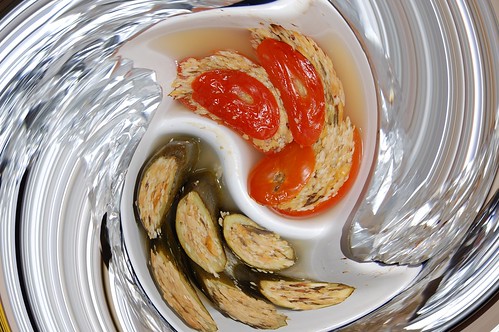
Time to draw a veil over this week's food activities. I've had not one, not two but three complete wipeouts in the kitchen wasting food and gas.
The first mistake is pictured above and below, a riff on Mediterranean stuffed vegetables. There's not really all that much wrong with them except they are entirely and totally unappetising. I've made a curry and 2 pints of soup so far in order to avoid eating these excrescences and even when I decided to hide the evidence by eating the photo shoot I gave up half way through because I simply couldn't force another mouthful in.
Then there were the sections of pumpkin, roasted because I had the oven on anyway. They weren't quite soft enough, so I left them in for another hour. I now have pumpkin leather, possibly of use to Ray Mears as something to sharpen his blade on or even to light fires but hardly edible.
Finally, there is no way on earth I will reveal what I did to a poor defenceless aubergine in the interests of research because it might lead someone of unsound mind to try to repeat the experiment and I couldn't take the guilt for the resulting disaster. It's very rare that food in my kitchen goes straight from oven to compost bin but this was a prime example. It makes me gag even to think about it.
So there you have it. Maybe I'm not cut out to be a top chef after all.

Sunday, May 24, 2009
Lagana and Etnos
We have a small book on Roman Cookery which makes fascinating reading. I've long wanted to try some of the dishes in it which have been translated from the original Latin, but although I have no doubt that the translations by this renowned scholar are good, as a cook some of the substitutions and modernisations seem bizarre.
Anyway, the first two dishes that seemed easy to bring back into the vegan repertoire are Etnos, a very simple dried pea soup that is still standard fare all over the globe and Lagana, which is fried pasta. This makes a sort of crisp puffy wafer, golden and with a snap to it. It seems the Italians didn't hit on the idea of boiling their pasta until the middle ages.
 This very simple fried bread was used to scoop up the soup as a sort of edible spoon. I am actually thrilled at how easy and effective this was, as my experience of frying flour and water pastes in the past has been mixed to say the least.
This very simple fried bread was used to scoop up the soup as a sort of edible spoon. I am actually thrilled at how easy and effective this was, as my experience of frying flour and water pastes in the past has been mixed to say the least.
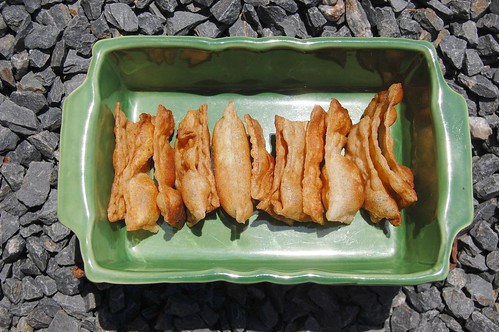
To make stacks of lagana (at least 100) you need:
150g flour. I think the type of flour is probably important. I used a medium atta, a wholemeal chapatti flour, sieved before weighing to remove the coarsest portions of the bran.
90-100ml water. Start with the lower amount and add a little extra if needed.
Oil, preferably olive, for cooking.
Mix the flour and water together to form a smooth pliable dough. Knead it for a minute or two. I wondered if it would need a rest period and tried cooking some immediately and then after a rest of a couple of hours but it seemed to make no difference.
Seasoning, there is none but I think some crushed pepper would sit nicely in this.
Roll small portions, the ubiquitous walnut sized lump springs to mind, out on a lightly floured board as thinly as you can, and I mean thinly but I didn't measure it, so I can't tell you exactly. Not quite as thin as phyllo pastry but getting there. After trimming the edges I got ten chips out of each of my walnut sized lumps.
I cut my sheets of rolled dough into rectangles about 2cm by 4cm which makes a good size for a couple of bites. The frying and rolling is probably best approached on a production line basis if you have help. I had to stop and take my pan off the heat a couple of times to roll out more crackers. The crisps cook so quickly that a constant feed stream is practical.
Heat about 1cm of oil in a heavy flat bottomed pan. The temperature needs to be just hot enough and shouldn't be smoking. Try a test piece, it should sizzle around the edges if the oil is hot enough. I used a frying pan but you could probably do this in a deep fryer if you wanted. Float each cut section on the oil. It will immediately puff up, sometimes in little bubbles but sometimes as perfect jolly little pillows. Turn them over almost immediately and allow the second side to cook, then remove from the oil and allow to drain on a rack or kitchen towel.
Like many fried goods these benefit from a few minutes in a warm oven to remove the greasiness so it's possible to cook quite a lot and keep them warm while you finish the batch.
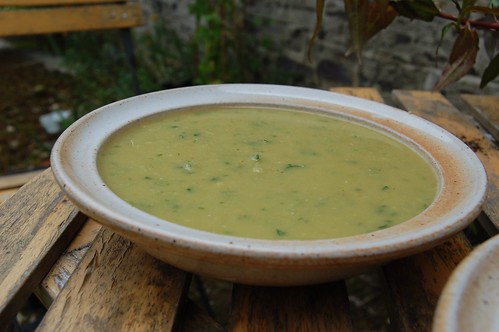
The soup is simply a couple of handfuls of split green peas, soaked over night and then cooked with a chopped leek or onion for an hour or so at a simmer until the pulses are completely soft. Whizz them up with a stick blender (or get the house slave to rub them through a sieve) and then season with herbs, salt and pepper. The Romans liked dill in their pea soups but mint or coriander are acceptable substitutes. A drizzle of olive oil is also used for flavour but I left it out of mine because of all the fried noodles to come.
The soup needs to be thick. If there's still a lot of water in the pan when the peas are cooked strain some off before blending or you'll have to do what I did and simmer the soup again to make it thicker.
The simple flavours and bland texture of the soup are an excellent match for the puffy, crispy lagana which worked really well as spoons. They are particularly good when they've formed pillows as you can use them to scoop up the soup inside them for a taste explosion when they get to the mouth. It's all pretty easy too. I'll be trying more recipes from this book over the summer.
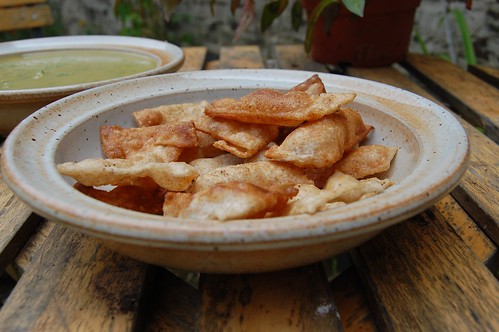
Anyway, the first two dishes that seemed easy to bring back into the vegan repertoire are Etnos, a very simple dried pea soup that is still standard fare all over the globe and Lagana, which is fried pasta. This makes a sort of crisp puffy wafer, golden and with a snap to it. It seems the Italians didn't hit on the idea of boiling their pasta until the middle ages.
 This very simple fried bread was used to scoop up the soup as a sort of edible spoon. I am actually thrilled at how easy and effective this was, as my experience of frying flour and water pastes in the past has been mixed to say the least.
This very simple fried bread was used to scoop up the soup as a sort of edible spoon. I am actually thrilled at how easy and effective this was, as my experience of frying flour and water pastes in the past has been mixed to say the least. 
To make stacks of lagana (at least 100) you need:
150g flour. I think the type of flour is probably important. I used a medium atta, a wholemeal chapatti flour, sieved before weighing to remove the coarsest portions of the bran.
90-100ml water. Start with the lower amount and add a little extra if needed.
Oil, preferably olive, for cooking.
Mix the flour and water together to form a smooth pliable dough. Knead it for a minute or two. I wondered if it would need a rest period and tried cooking some immediately and then after a rest of a couple of hours but it seemed to make no difference.
Seasoning, there is none but I think some crushed pepper would sit nicely in this.
Roll small portions, the ubiquitous walnut sized lump springs to mind, out on a lightly floured board as thinly as you can, and I mean thinly but I didn't measure it, so I can't tell you exactly. Not quite as thin as phyllo pastry but getting there. After trimming the edges I got ten chips out of each of my walnut sized lumps.
I cut my sheets of rolled dough into rectangles about 2cm by 4cm which makes a good size for a couple of bites. The frying and rolling is probably best approached on a production line basis if you have help. I had to stop and take my pan off the heat a couple of times to roll out more crackers. The crisps cook so quickly that a constant feed stream is practical.
Heat about 1cm of oil in a heavy flat bottomed pan. The temperature needs to be just hot enough and shouldn't be smoking. Try a test piece, it should sizzle around the edges if the oil is hot enough. I used a frying pan but you could probably do this in a deep fryer if you wanted. Float each cut section on the oil. It will immediately puff up, sometimes in little bubbles but sometimes as perfect jolly little pillows. Turn them over almost immediately and allow the second side to cook, then remove from the oil and allow to drain on a rack or kitchen towel.
Like many fried goods these benefit from a few minutes in a warm oven to remove the greasiness so it's possible to cook quite a lot and keep them warm while you finish the batch.

The soup is simply a couple of handfuls of split green peas, soaked over night and then cooked with a chopped leek or onion for an hour or so at a simmer until the pulses are completely soft. Whizz them up with a stick blender (or get the house slave to rub them through a sieve) and then season with herbs, salt and pepper. The Romans liked dill in their pea soups but mint or coriander are acceptable substitutes. A drizzle of olive oil is also used for flavour but I left it out of mine because of all the fried noodles to come.
The soup needs to be thick. If there's still a lot of water in the pan when the peas are cooked strain some off before blending or you'll have to do what I did and simmer the soup again to make it thicker.
The simple flavours and bland texture of the soup are an excellent match for the puffy, crispy lagana which worked really well as spoons. They are particularly good when they've formed pillows as you can use them to scoop up the soup inside them for a taste explosion when they get to the mouth. It's all pretty easy too. I'll be trying more recipes from this book over the summer.

Saturday, May 23, 2009
Hungry Gap Risotto
Wednesday, May 20, 2009
Too hungry
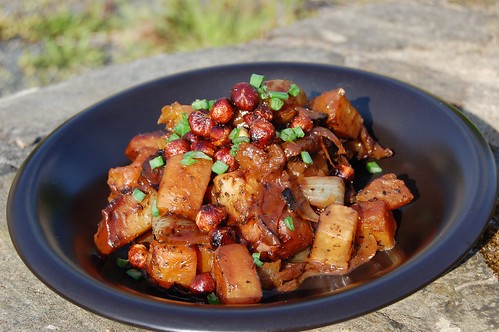
Pan Braised Potato, Pumpkin, Celeriac and Onion in a Miso Wine gravy with Toasted Hazelnuts.
This was supposed to have been oven roasted veggies, cooked along with a loaf of bread to save fuel, but the dough was slow and I was too hungry to wait. Perhaps a bit wintery for the time of year but it's still pretty cold here in the evenings.
Vegetables were pan fried with just a little oil, slowly so that they gained some colour and flavour, then a miso and wine stock was added and the pan lid put on to complete the cooking. The lid doesn't fit too well and there was a little evaporation which helped the sauce thicken.
The toasted hazelnuts were sprinkled over for added crunch and protein.
It's all very well announcing I'll be eating from a menu plan but that means I have to make one. I had no idea there were so many recipes in my 'good ideas to try' box but I'm making some lists now. There should be enough variety that I can post a couple of new experiments each week without giving up on old favourites already blogged.
Sunday, May 17, 2009
A good plain cake
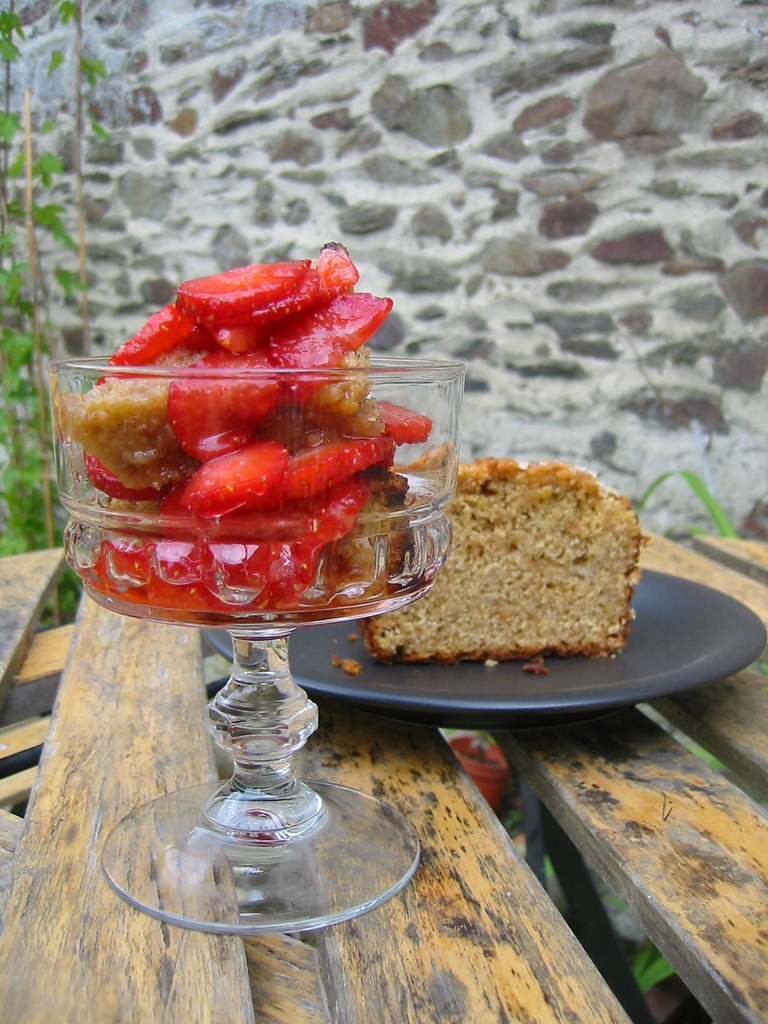
It sounds like something out of Mrs. Beaton, Plain cake, suitable for children and servants. But, it's simple, fool proof and can be soaked with brandy, filled with fruit and glazed with sugar for extra fancyness if required.
The only thing I'd change when making this again is to use a white flour instead of the wholemeal used here. It was just a bit too worthy for a celebration and I much prefer bread to cake for every day use.
250g flour
100g sugar
1 pkt. (11g) baking powder
100g soy yoghurt
100ml (about two small fruits worth) fresh orange juice
1 medium banana, well mashed
100g light flavoured oil
Mix the dry ingredients in a bowl. Mix the wet ingredients in a separate bowl and then add the dry ingredients to them. Mix just well enough to combine evenly and scrape into a well greased and floured loaf tin. Smooth the top gently.
Bake at about 200C for about 40 minutes. It will rise to the top of the tin and become firm and golden. Test with a skewer and make sure your cranky and inconsistent gas oven doesn't burn the bottom before cooking the middle.
The serving suggestion has sliced strawberries macerated in sugar and a little Rivesaltes Ambre atop a couple of sections of trimmed cake. What's not to like?
Thursday, May 14, 2009
Health and Beauty
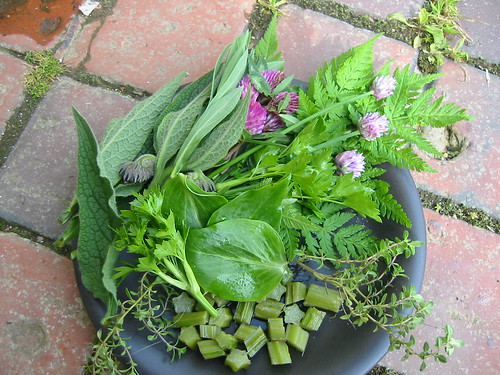
A bunch of weeds and herbs including red valerian, scuplit, sorrel, sweet cicely, chives and flowers, clover flowers, comfrey, bramble shoots, parsley, tarragon, sage and lemon thyme.
One of the main reasons for writing this blog is that when I'm on my own I don't eat healthily, usually choosing easy starchy snacks to pick at along with a lot of strong coffee.
This season I've not been managing very well at all, firstly with the excuse of not having the option of particularly fresh foods and now, because I have access to junk food again, the ability to avoid healthy eating with 'treats'. It's got to stop.
Tomorrow, Mr. S-C will be back for the weekend so I'm planning to bake him a cake and a nice dinner which may or may not be blogged but starting Monday it's going back to working to a menu plan and no more cheating.
Tonight, a rather pedestrian selection of tomato, cucumber, onion and chopped chicon has been enlivened with the bunch of foraged greens and herbs shown above. The dressing was made with olive oil, mustard and sherry vinegar which I find much preferable to the rather abused balsamic available in supermarkets (although if anyone would like to gift me a drop of the real stuff I'd be very grateful!).
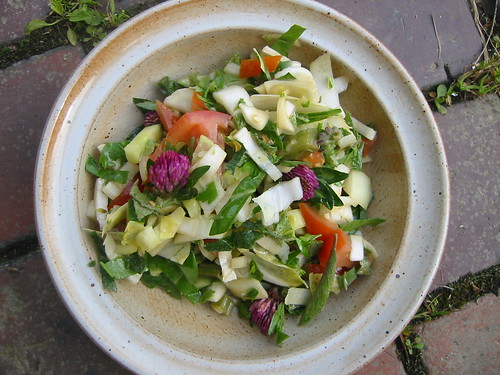
Subscribe to:
Posts (Atom)
